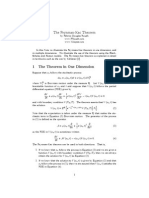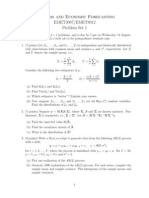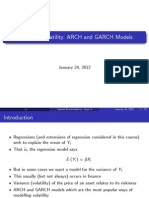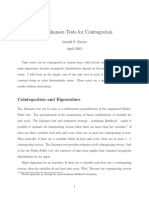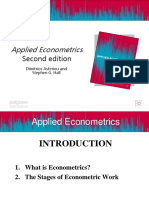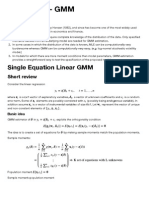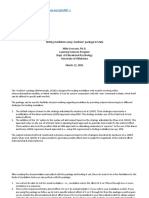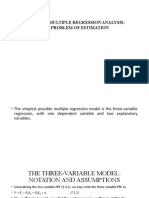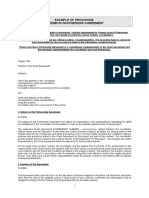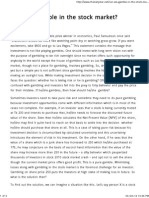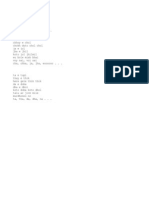ARDL Bound Test
ARDL Bound Test
Uploaded by
himu6749721Copyright:
Available Formats
ARDL Bound Test
ARDL Bound Test
Uploaded by
himu6749721Original Description:
Copyright
Available Formats
Share this document
Did you find this document useful?
Is this content inappropriate?
Copyright:
Available Formats
ARDL Bound Test
ARDL Bound Test
Uploaded by
himu6749721Copyright:
Available Formats
Data Analysis & Forecasting
Faculty of Development Economics
TIME SERIES ANALYSIS
BOUNDS TEST FOR COINTEGRATION WITHIN ARDL
MODELLING APPROACH
Another way to test for cointegration and causality is the Bounds Test for Cointegration
within ARDL modelling approach. This model was developed by Pesaran et al. (2001) and
can be applied irrespective of the order of integration of the variables (irrespective of
whether regressors are purely I (0), purely I (1) or mutually cointegrated). This is specially
linked with the ECM models and called VECM.
1. THE MODEL
The ARDL modelling approach involves estimating the following error correction models:
n
i =1
j=1
i =1
j=1
Yt = 0 y + 1y Yt 1 + 2 y X t 1 + i Yt i + j X t j + u yt
X t = 0 x + 1x Yt 1 + 2 x X t 1 + i X t i + j Yt j + u xt
(1)
(2)
Important note is the same as the Standard Granger Causality.
2. TEST PROCEDURE
Suppose we have Yt and Xt are nonstationary.
THE DYNAMIC GRANGER CAUSALITY is performed as follows:
Step 1: Testing for the unit root of Yt and Xt
(using either DF, ADF, or PP tests)
Suppose the test results indicate that Yt and Xt have different orders of integration.
Step 2: Testing for cointegration between Yt and Xt
(usually use Bounds test approach)
For equations 1 and 2, the F-test (normal Wald test) is used for investigating one or more
long-run relationships. In the case of one or more long-run relationships, the F-test indicates
which variable should be normalized. In Equation 1, when Y is the dependent variable, the
null hypothesis of no cointegration is H0: 1y = 2y = 0 and the alternative hypothesis of
cointegration is H1: 1y 2y 0. On the other hand, in Equation 2, when X is the
dependent variable, the null hypothesis of no cointegration is H0: 1x = 2x = 0 and the
alternative hypothesis of cointegration is H1: 1x 2x 0.
Step 3: Testing for Granger Causality?
Questions: How to explain the test results?
Phung Thanh Binh (2010)
You might also like
- Lecture 4 ARDL - Bounds - TestDocument58 pagesLecture 4 ARDL - Bounds - TestFixque AXNo ratings yet
- The Feynman-Kac TheoremDocument7 pagesThe Feynman-Kac TheoremAshwini Kumar PalNo ratings yet
- Chapter Twenty - Time SeriesDocument21 pagesChapter Twenty - Time SeriesSDB_EconometricsNo ratings yet
- International Finance PDFDocument339 pagesInternational Finance PDFcmukherjeeNo ratings yet
- Business and Economic Forecasting EMET3007/EMET8012 Problem Set 1Document2 pagesBusiness and Economic Forecasting EMET3007/EMET8012 Problem Set 1Ly SopheaNo ratings yet
- Introduction To Econometrics, TutorialDocument10 pagesIntroduction To Econometrics, Tutorialagonza70No ratings yet
- Analyze The Report of Swedish Motor InsuranceDocument14 pagesAnalyze The Report of Swedish Motor InsurancebhadavNo ratings yet
- AutocorrelationDocument172 pagesAutocorrelationJenab Peteburoh100% (1)
- Solutions Manual to Accompany Introduction to Quantitative Methods in Business: with Applications Using Microsoft Office ExcelFrom EverandSolutions Manual to Accompany Introduction to Quantitative Methods in Business: with Applications Using Microsoft Office ExcelNo ratings yet
- Financial Econometrics and Empirical Finance - Module 2 General Exam Solutions - July 2012Document25 pagesFinancial Econometrics and Empirical Finance - Module 2 General Exam Solutions - July 2012Sunny DeolNo ratings yet
- Ch-2, Determination of Intt RatesDocument19 pagesCh-2, Determination of Intt RatesAR RafiNo ratings yet
- 004 - Modelling Volatility - Arch and Garch ModelsDocument31 pages004 - Modelling Volatility - Arch and Garch ModelsĐông Đông0% (1)
- Forecasting and VAR Models - PresentationDocument11 pagesForecasting and VAR Models - PresentationFranz EignerNo ratings yet
- 2SLS Klein Macro PDFDocument4 pages2SLS Klein Macro PDFNiken DwiNo ratings yet
- Johansen Cointegration TestDocument7 pagesJohansen Cointegration TestLazarus PittNo ratings yet
- 3SLS and FIMLDocument5 pages3SLS and FIMLDavidBudinasNo ratings yet
- Multicollinearity Among The Regressors Included in The Regression ModelDocument13 pagesMulticollinearity Among The Regressors Included in The Regression ModelNavyashree B MNo ratings yet
- Chapter 02 - The Structure of Economic Data and Basic Data HandlingDocument12 pagesChapter 02 - The Structure of Economic Data and Basic Data HandlingMuntazir HussainNo ratings yet
- Structural VAR and Applications: Jean-Paul RenneDocument55 pagesStructural VAR and Applications: Jean-Paul RennerunawayyyNo ratings yet
- FI4003 Lec Cointegration and EcmDocument31 pagesFI4003 Lec Cointegration and Ecmearn0512No ratings yet
- Introducing Advanced Macroeconomics:: Growth and Business Cycles CyclesDocument28 pagesIntroducing Advanced Macroeconomics:: Growth and Business Cycles CyclesIzzat MushtaqNo ratings yet
- Econometric SDocument26 pagesEconometric SMunnah BhaiNo ratings yet
- Ch2 SlidesDocument80 pagesCh2 SlidesYiLinLiNo ratings yet
- Import Substitution And/or Export Led Growth Necessary For The Economic Development of BangladeshDocument11 pagesImport Substitution And/or Export Led Growth Necessary For The Economic Development of Bangladesholiur rahman100% (2)
- GMMDocument20 pagesGMMsaw4321No ratings yet
- Guide On Multiple RegressionDocument29 pagesGuide On Multiple RegressionLucyl MendozaNo ratings yet
- Autocorrelation: What Happens If The Error Terms Are Correlated?Document18 pagesAutocorrelation: What Happens If The Error Terms Are Correlated?Nusrat Jahan MoonNo ratings yet
- ARCH ModelDocument26 pagesARCH ModelAnish S.MenonNo ratings yet
- Foster-Greer-Thorbecke Indices - WikipediaDocument2 pagesFoster-Greer-Thorbecke Indices - Wikipediariswandi -No ratings yet
- Advantages of ARDL MODELDocument11 pagesAdvantages of ARDL MODELMuhammad Saeed MeoNo ratings yet
- Homoscedastic That Is, They All Have The Same Variance: HeteroscedasticityDocument11 pagesHomoscedastic That Is, They All Have The Same Variance: HeteroscedasticityNavyashree B M100% (1)
- Consumption TheoriesDocument19 pagesConsumption TheoriesEmaan AnumNo ratings yet
- A Brief Overview of The Classical Linear Regression Model: Introductory Econometrics For Finance' © Chris Brooks 2013 1Document80 pagesA Brief Overview of The Classical Linear Regression Model: Introductory Econometrics For Finance' © Chris Brooks 2013 1sdfasdgNo ratings yet
- Var SvarDocument31 pagesVar SvarEddie Barrionuevo100% (1)
- Robinsons Growth Model 2nd SemDocument27 pagesRobinsons Growth Model 2nd SemRanvika ChopraNo ratings yet
- Drukker XTDPDDocument34 pagesDrukker XTDPDBenychouNo ratings yet
- ARDLDocument10 pagesARDLAdnan SethiNo ratings yet
- Testing Mediation Using Medsem' Package in StataDocument17 pagesTesting Mediation Using Medsem' Package in StataAftab Tabasam0% (1)
- Chapter 6Document29 pagesChapter 6Bereket DesalegnNo ratings yet
- Chapters 1 & 2-Final - PPT Econmetrics - Smith/WatsonDocument71 pagesChapters 1 & 2-Final - PPT Econmetrics - Smith/WatsonAlozie Iheduru100% (1)
- Arch Garch AssignmentDocument5 pagesArch Garch AssignmentSurbhiVijhaniNo ratings yet
- Chapter # 6: Multiple Regression Analysis: The Problem of EstimationDocument43 pagesChapter # 6: Multiple Regression Analysis: The Problem of EstimationRas DawitNo ratings yet
- 007 - Buku Basic Econometric Damodar N Gujarati 4th Solution-15-25Document12 pages007 - Buku Basic Econometric Damodar N Gujarati 4th Solution-15-25Kurniawan ArikaNo ratings yet
- ARDLDocument13 pagesARDLSayed Farrukh AhmedNo ratings yet
- MSC Economics Ec413 Macroeconomics: Real Business Cycles IiDocument21 pagesMSC Economics Ec413 Macroeconomics: Real Business Cycles Iikokibonilla123No ratings yet
- The Cagan Model PDFDocument2 pagesThe Cagan Model PDFMauricioNo ratings yet
- Dummy Dependent Variables ModelsDocument15 pagesDummy Dependent Variables ModelsBrinda RamNo ratings yet
- VAR, SVAR and VECMDocument57 pagesVAR, SVAR and VECMjohnpaulcorpus100% (1)
- Time Series QuestionsDocument9 pagesTime Series Questionsakriti_08100% (1)
- 2 Growth Neoclassical GrowthDocument71 pages2 Growth Neoclassical GrowthPAOLA NELLY ROJAS VALERONo ratings yet
- FMOLS ModelDocument8 pagesFMOLS ModelSayed Farrukh AhmedNo ratings yet
- Linear Regression Analysis For STARDEX: Trend CalculationDocument6 pagesLinear Regression Analysis For STARDEX: Trend CalculationSrinivasu UpparapalliNo ratings yet
- HeteroskedasticityDocument30 pagesHeteroskedasticityallswellNo ratings yet
- Panel Stata InstructionsDocument4 pagesPanel Stata InstructionsMarjan NaseriNo ratings yet
- Var SlidesDocument28 pagesVar SlidespinakimahataNo ratings yet
- 202003271457478511akash HeteroscedasticityDocument16 pages202003271457478511akash HeteroscedasticitySayed SalarNo ratings yet
- Markov Interest Rate Models - Hagan and WoodwardDocument28 pagesMarkov Interest Rate Models - Hagan and WoodwardlucaliberaceNo ratings yet
- ARDLDocument3 pagesARDLMohammed SeidNo ratings yet
- Chapter 10 - Aggregate Demand IDocument30 pagesChapter 10 - Aggregate Demand IwaysNo ratings yet
- WHO Database Template 2017Document2 pagesWHO Database Template 2017himu6749721No ratings yet
- Partnership Agreement - ExampleDocument8 pagesPartnership Agreement - Examplehimu6749721No ratings yet
- Chapter 1 - Introduction To StatisticsDocument38 pagesChapter 1 - Introduction To Statisticshimu6749721No ratings yet
- Stabilising Share MarketDocument3 pagesStabilising Share Markethimu6749721No ratings yet
- Masud Rana 172-173 - Juaree 1,2Document195 pagesMasud Rana 172-173 - Juaree 1,2himu6749721No ratings yet
- Star Weekend MagazineDocument3 pagesStar Weekend Magazinehimu6749721No ratings yet
- 00 Lecture Notes KuhntuckerDocument9 pages00 Lecture Notes Kuhntuckerhimu6749721No ratings yet
- Star Weekend Magazine1Document3 pagesStar Weekend Magazine1himu6749721No ratings yet
- Can We Gamble in The Stock MarketDocument3 pagesCan We Gamble in The Stock Markethimu6749721No ratings yet
- Is The Bull Market SustainableDocument5 pagesIs The Bull Market Sustainablehimu6749721No ratings yet
- How To Write ProofsDocument25 pagesHow To Write Proofshimu6749721No ratings yet
- Song of Bangla AlphabetDocument1 pageSong of Bangla Alphabethimu6749721100% (1)

